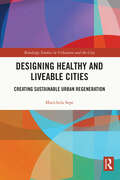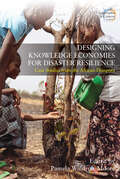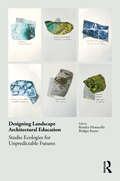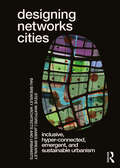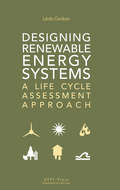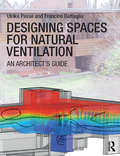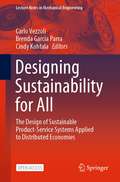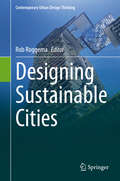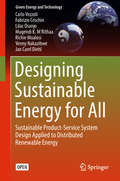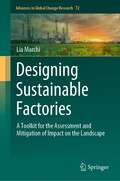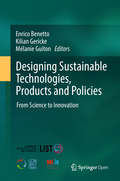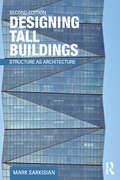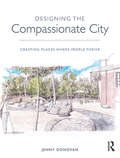- Table View
- List View
Designing Green Spaces for Health: Using Plants to Reduce the Spread of Airborne Viruses
by Stevie FamulariThis book focuses on using plants in spatial design to reduce the infectiousness of viruses in different working and living spaces. It presents strategies for interior and exterior green designs with plants that are likely effective for flu virus tolerance and reduction of infectiousness. The designs are appealing for interaction and healing, as well as focusing on the reduction and removal of virus infectiousness. The Famulari Theory requires examining plants that are likely effective for virus accumulation based on their leaves with stomata, trichomes, and dense leaf growth, and transpiration rate accumulation of airborne viruses. In addition, this research requires reviewing the quantity and specific types of plants (as well as electronic sources, such as humidifiers and water features) needed to produce effective humidity for plants to decrease the infectiousness or transmission of viruses; the effective distance of people to plants; and light, water, soil, and temperature needs. The book addresses the various greening practices that can be applied to sites to reduce the infectiousness of the airborne flu virus – especially in areas such as train stations, restaurants, rooftops, courtyards, office buildings and work spaces/conference rooms, and the home office – and the ways that businesses owners and residents can integrate these practices to reduce the air contaminants with a green solution. Designing green spaces that accumulate, reduce, and remove the infectiousness of viruses involves exploring multiple approaches from different directions to achieve the most effective and ideal design. The six basic approaches include 1. Temperature minimum of 70° Fahrenheit 2. Plants with multiple stomata on the leaf surfaces 3. Plants with multiple clumps of dense leaves with a high transpiration rate 4. Plants with rough leaf surfaces or with trichomes (plant hairs) on the leaf 5. Relative humidity (RH) minimum of 43% or higher 6. Air circulation to direct air with the airborne flu virus to the planted areas Stevie Famulari brings unique insights and inspires the development of green understanding and design solution plans with both short-term and long-term approaches. Illustrations of greening applied to locations help you understand your own design solutions to create them in your site. This book breaks down the misconceptions of the complexity of sustainability and green practices and provides illustrations and site-appropriate green solutions that you can incorporate into your lifestyle for a healthier site. Greening is a lifestyle change, and this guide lets you know how easy it is to transition to the green side to improve your health.
Designing Green Spaces for Health: Using Plants to Reduce the Spread of Airborne Viruses
by Stevie FamulariThis book focuses on using plants in spatial design to reduce the infectiousness of viruses in different working and living spaces. It presents strategies for interior and exterior green designs with plants that are likely effective for flu virus tolerance and reduction of infectiousness. The designs are appealing for interaction and healing, as well as focusing on the reduction and removal of virus infectiousness. The Famulari Theory requires examining plants that are likely effective for virus accumulation based on their leaves with stomata, trichomes, and dense leaf growth, and transpiration rate accumulation of airborne viruses. In addition, this research requires reviewing the quantity and specific types of plants (as well as electronic sources, such as humidifiers and water features) needed to produce effective humidity for plants to decrease the infectiousness or transmission of viruses; the effective distance of people to plants; and light, water, soil, and temperature needs. The book addresses the various greening practices that can be applied to sites to reduce the infectiousness of the airborne flu virus – especially in areas such as train stations, restaurants, rooftops, courtyards, office buildings and work spaces/conference rooms, and the home office – and the ways that businesses owners and residents can integrate these practices to reduce the air contaminants with a green solution. Designing green spaces that accumulate, reduce, and remove the infectiousness of viruses involves exploring multiple approaches from different directions to achieve the most effective and ideal design. The six basic approaches include 1. Temperature minimum of 70° Fahrenheit 2. Plants with multiple stomata on the leaf surfaces 3. Plants with multiple clumps of dense leaves with a high transpiration rate 4. Plants with rough leaf surfaces or with trichomes (plant hairs) on the leaf 5. Relative humidity (RH) minimum of 43% or higher 6. Air circulation to direct air with the airborne flu virus to the planted areas Stevie Famulari brings unique insights and inspires the development of green understanding and design solution plans with both short-term and long-term approaches. Illustrations of greening applied to locations help you understand your own design solutions to create them in your site. This book breaks down the misconceptions of the complexity of sustainability and green practices and provides illustrations and site-appropriate green solutions that you can incorporate into your lifestyle for a healthier site. Greening is a lifestyle change, and this guide lets you know how easy it is to transition to the green side to improve your health.
Designing Healthy and Liveable Cities: Creating Sustainable Urban Regeneration (Routledge Studies in Urbanism and the City)
by Marichela SepeIn the last ten years, concepts such as urban health and liveability have become ever more present in urban planning studies. Many companies rank the most liveable city in the world or in a nation, and many indicators are used to try to measure factors which can report the health of a place by investigating it in different ways. While it is possible to understand why a place is liveable – due to the liveability and health concepts that are being more and more explored in urban studies, and the strong influence coming from other disciplines – it is difficult to design a place that is certain to be healthy and liveable. Accordingly, aim of this book is, after the definition of the field of investigation concerning sustainable regeneration trough topics such as resilience, adaptation, health, and mixed connections, to illustrate the present-day approaches to the analysis and design of healthy places, and in particular the original Healthy Pl@ce Design method, flexible and repeatable in different contexts. The method aims to identify sustainable urban liveability and healthiness and the factors which make places liveable and healthy from users' points of view and identifying design interventions that can enhance or create both urban liveability and health. Emblematic case studies carried out in Europe, Canada and China – Bordeaux, Copenhagen, Hamburg, Madrid, Newcastle–Gateshead, Nice, Dublin, Vancouver and Wuhan – constitute the empirical part of the book, detailed with surveys, questionnaires, images and maps. The theoretical framework – built on contemporary issues – and international case studies make this book both attractive and scientific, adding a new stone on the sustainable city construction and opening it to a particularly wide readership, including scholars, students, administrators and professionals.
Designing Healthy and Liveable Cities: Creating Sustainable Urban Regeneration (Routledge Studies in Urbanism and the City)
by Marichela SepeIn the last ten years, concepts such as urban health and liveability have become ever more present in urban planning studies. Many companies rank the most liveable city in the world or in a nation, and many indicators are used to try to measure factors which can report the health of a place by investigating it in different ways. While it is possible to understand why a place is liveable – due to the liveability and health concepts that are being more and more explored in urban studies, and the strong influence coming from other disciplines – it is difficult to design a place that is certain to be healthy and liveable. Accordingly, aim of this book is, after the definition of the field of investigation concerning sustainable regeneration trough topics such as resilience, adaptation, health, and mixed connections, to illustrate the present-day approaches to the analysis and design of healthy places, and in particular the original Healthy Pl@ce Design method, flexible and repeatable in different contexts. The method aims to identify sustainable urban liveability and healthiness and the factors which make places liveable and healthy from users' points of view and identifying design interventions that can enhance or create both urban liveability and health. Emblematic case studies carried out in Europe, Canada and China – Bordeaux, Copenhagen, Hamburg, Madrid, Newcastle–Gateshead, Nice, Dublin, Vancouver and Wuhan – constitute the empirical part of the book, detailed with surveys, questionnaires, images and maps. The theoretical framework – built on contemporary issues – and international case studies make this book both attractive and scientific, adding a new stone on the sustainable city construction and opening it to a particularly wide readership, including scholars, students, administrators and professionals.
Designing Knowledge Economies for Disaster Resilience: Case Studies from the African Diaspora (Catastrophes in Context #7)
by Pamela Waldron-MooreDisaster research has been studied from many angles, seldom targeting its implications for vulnerable territories in Africa. Entities most subject to the effects of climate change are often undeveloped and located in disadvantaged regions. Post-disaster communities need to scrutinize the social, political, economic, and cultural structures that stagnate sustainable growth. Acknowledging that low economic development and high climate costs cannot coexist, this collected volume interrogates the challenge for disaster-prone territories to determine strategies for restructuring and redesigning their environment. This book proposes the creation of knowledge economies, whereby empowered communities may produce innovative knowledge translatable across the African diaspora.
Designing Knowledge Economies for Disaster Resilience: Case Studies from the African Diaspora (Catastrophes in Context #7)
by Pamela Waldron-MooreDisaster research has been studied from many angles, seldom targeting its implications for vulnerable territories in Africa. Entities most subject to the effects of climate change are often undeveloped and located in disadvantaged regions. Post-disaster communities need to scrutinize the social, political, economic, and cultural structures that stagnate sustainable growth. Acknowledging that low economic development and high climate costs cannot coexist, this collected volume interrogates the challenge for disaster-prone territories to determine strategies for restructuring and redesigning their environment. This book proposes the creation of knowledge economies, whereby empowered communities may produce innovative knowledge translatable across the African diaspora.
Designing Knowledge Economies for Disaster Resilience: Case Studies from the African Diaspora (Catastrophes in Context #7)
by Pamela Waldron-MooreDisaster research has been studied from many angles, seldom targeting its implications for vulnerable territories in Africa. Entities most subject to the effects of climate change are often undeveloped and located in disadvantaged regions. Post-disaster communities need to scrutinize the social, political, economic, and cultural structures that stagnate sustainable growth. Acknowledging that low economic development and high climate costs cannot coexist, this collected volume interrogates the challenge for disaster-prone territories to determine strategies for restructuring and redesigning their environment. This book proposes the creation of knowledge economies, whereby empowered communities may produce innovative knowledge translatable across the African diaspora.
Designing Knowledge Economies for Disaster Resilience: Case Studies from the African Diaspora (Catastrophes in Context #7)
Disaster research has been studied from many angles, seldom targeting its implications for vulnerable territories in Africa. Entities most subject to the effects of climate change are often undeveloped and located in disadvantaged regions. Post-disaster communities need to scrutinize the social, political, economic, and cultural structures that stagnate sustainable growth. Acknowledging that low economic development and high climate costs cannot coexist, this collected volume interrogates the challenge for disaster-prone territories to determine strategies for restructuring and redesigning their environment. This book proposes the creation of knowledge economies, whereby empowered communities may produce innovative knowledge translatable across the African diaspora.
Designing Landscape Architectural Education: Studio Ecologies for Unpredictable Futures
by Rosalea Monacella Bridget KeaneNo single project or endeavour is immune to the issues that the climate crisis brings. The climate crisis encompasses a broad register of "symptoms" – increased global temperatures and sea-level rise, droughts and extreme bushfire events, salinification and desertification of fertile land, and the list goes on. It reveals and amplifies complex causal relationships that are inherently present and traverse scales, sectors and communities divulging a range of impacts and inequalities. This publication asks designers and academic practitioners to describe their own work through an ecological lens, and then to articulate design approaches for developing new practices in landscape architecture teaching. Designing Landscape Architectural Education: Studio Ecologies for Unpredictable Futures, the Landscape Architecture Design Studio Companion, serves as a resource for academic practitioners in the preparation and delivery of "design-research studios" and students seeking guidance for design methodologies as a part of their landscape architectural education. It draws on the manifold issues of the climate crisis as a set of drivers to examine the utilisation of a range of innovative design approaches to address the current and future priorities of the discipline. The landscape architecture discipline is evolving rapidly to respond to both a broadening and intensification of changes in the environmental, social and political conditions. These changing conditions require innovation that extend the core competencies of landscape architects. This book addresses two fundamental questions – what are the design competencies required of landscape architects to equip them to deal with the complexities brought forth by contemporary society, and as a result, how could we design the future design studio?
Designing Landscape Architectural Education: Studio Ecologies for Unpredictable Futures
by Rosalea Monacella and Bridget KeaneNo single project or endeavour is immune to the issues that the climate crisis brings. The climate crisis encompasses a broad register of "symptoms" – increased global temperatures and sea-level rise, droughts and extreme bushfire events, salinification and desertification of fertile land, and the list goes on. It reveals and amplifies complex causal relationships that are inherently present and traverse scales, sectors and communities divulging a range of impacts and inequalities. This publication asks designers and academic practitioners to describe their own work through an ecological lens, and then to articulate design approaches for developing new practices in landscape architecture teaching. Designing Landscape Architectural Education: Studio Ecologies for Unpredictable Futures, the Landscape Architecture Design Studio Companion, serves as a resource for academic practitioners in the preparation and delivery of "design-research studios" and students seeking guidance for design methodologies as a part of their landscape architectural education. It draws on the manifold issues of the climate crisis as a set of drivers to examine the utilisation of a range of innovative design approaches to address the current and future priorities of the discipline. The landscape architecture discipline is evolving rapidly to respond to both a broadening and intensification of changes in the environmental, social and political conditions. These changing conditions require innovation that extend the core competencies of landscape architects. This book addresses two fundamental questions – what are the design competencies required of landscape architects to equip them to deal with the complexities brought forth by contemporary society, and as a result, how could we design the future design studio?
Designing Networks Cities: Inclusive, Hyper-Connected, Emergent, and Sustainable Urbanism
by Steve Whitford James Brearleydesigning networks cities presents a sophisticated, multi-disciplinary, and multi-dimensional approach to urban design. Emerging from years of practice, experimentation, and research by designers (landscape architects, urban planners, urban designers and architects), this approach engages with contemporary thought across a number of disciplines to re-invent the entrenched blunt instruments of the city making process. A cry for flexible, sharp-instruments in urban design, designing networks cities presents a multi-dimensional way of seeing the essential components of the city (form, space-time, order and aesthetics). It purposefully links traditional architectural design derivation mechanisms to urban design, in the hope that cities will not only be pragmatic, but also become sophisticated iconographically, poetically, and syntactically. It provides the tools to enable decision making within a multiplicity of constraints and opportunities: a philosophy of becoming, not being; a science of dynamic systems, not stasis; and an art of sensations, not subjectivity. And finally, and most importantly, it argues why it is important that cities embrace these multiple dimensions of society on a planet that is facing increasing environmental challenges: an economics focused on equity for all, not for some more than others; a politics supporting a genuine representational democracy, not one representing the overly influential; and a culture [including history] that embraces difference, not one that encourages division. designing networks cities not only provides the means to identify these issues and a methodology to deal with them within a complex emerging co-existence, but also demonstrates the development of cities that embrace and respond to the complexities of life in what some are calling the Anthropocene.
Designing Networks Cities: Inclusive, Hyper-Connected, Emergent, and Sustainable Urbanism
by Steve Whitford James Brearleydesigning networks cities presents a sophisticated, multi-disciplinary, and multi-dimensional approach to urban design. Emerging from years of practice, experimentation, and research by designers (landscape architects, urban planners, urban designers and architects), this approach engages with contemporary thought across a number of disciplines to re-invent the entrenched blunt instruments of the city making process. A cry for flexible, sharp-instruments in urban design, designing networks cities presents a multi-dimensional way of seeing the essential components of the city (form, space-time, order and aesthetics). It purposefully links traditional architectural design derivation mechanisms to urban design, in the hope that cities will not only be pragmatic, but also become sophisticated iconographically, poetically, and syntactically. It provides the tools to enable decision making within a multiplicity of constraints and opportunities: a philosophy of becoming, not being; a science of dynamic systems, not stasis; and an art of sensations, not subjectivity. And finally, and most importantly, it argues why it is important that cities embrace these multiple dimensions of society on a planet that is facing increasing environmental challenges: an economics focused on equity for all, not for some more than others; a politics supporting a genuine representational democracy, not one representing the overly influential; and a culture [including history] that embraces difference, not one that encourages division. designing networks cities not only provides the means to identify these issues and a methodology to deal with them within a complex emerging co-existence, but also demonstrates the development of cities that embrace and respond to the complexities of life in what some are calling the Anthropocene.
Designing Optimal Strategies for Mineral Exploration
by J.G. De Geoffroy T.K. WignallFew knowledgeable people would deny that the field of mineral exploration is facing some difficult times in the foreseeable future. Among the woes, we can cite a worldwide economic uneasiness reflected by sluggish and at times widely fluctuating metal prices, global financial uncertainties, and relentless pressures on costs despite a substantial slowing down of the rate of inflation. Furthermore, management is forced to tum to more sophisticated and expensive technologies and to look farther afield to more remote regions, as the better quality and more easily accessible ore deposits have now been revealed. This rather gloomy outlook should persuade explorationists to cast about for a new philosophy with which to guide mineral exploration through the challenging decades ahead. Once already, in the early 1960s, a call for change had been heard (Ref. 30 in Chapter 1), when it became obvious that the prospecting methods of yesteryear, so successful in the past, could not keep up with the rapidly growing demand for minerals of the postwar period. The answer, a massive introduction of sophisticated geophysical and geochemical technologies backed by new geo logical models, proved spectacularly successful throughout the 1960s and the 1970s. But for both economic and technological reasons, the brisk pace of the last two decades has considerably slowed down in the early 1980s, as if a new threshold has been reached.
Designing Renewable Energy Systems: A Life Cycle Assessment Approach
by Leda GerberThe book discusses a multi-objective optimization approach in LCA that allows the flexible construction of comprehensive Pareto fronts to help understand the weightings and relative importance of its elements. The methodology is applied to the pertinent topics of thermochemical wood conversion, deep geothermal energy, and regional energy planning.
Designing Spaces for Natural Ventilation: An Architect's Guide
by Ulrike Passe Francine BattagliaBuildings can breathe naturally, without the use of mechanical systems, if you design the spaces properly. This accessible and thorough guide shows you how in more than 260 color diagrams and photographs illustrating case studies and CFD simulations. You can achieve truly natural ventilation, by considering the building's structure, envelope, energy use, and form, as well as giving the occupants thermal comfort and healthy indoor air. By using scientific and architectural visualization tools included here, you can develop ventilation strategies without an engineering background. Handy sections that summarize the science, explain rules of thumb, and detail the latest research in thermal and fluid dynamics will keep your designs sustainable, energy efficient, and up-to-date.
Designing Spaces for Natural Ventilation: An Architect's Guide
by Ulrike Passe Francine BattagliaBuildings can breathe naturally, without the use of mechanical systems, if you design the spaces properly. This accessible and thorough guide shows you how in more than 260 color diagrams and photographs illustrating case studies and CFD simulations. You can achieve truly natural ventilation, by considering the building's structure, envelope, energy use, and form, as well as giving the occupants thermal comfort and healthy indoor air. By using scientific and architectural visualization tools included here, you can develop ventilation strategies without an engineering background. Handy sections that summarize the science, explain rules of thumb, and detail the latest research in thermal and fluid dynamics will keep your designs sustainable, energy efficient, and up-to-date.
Designing Sustainability for All: The Design of Sustainable Product-Service Systems Applied to Distributed Economies (Lecture Notes in Mechanical Engineering)
by Carlo Vezzoli Brenda Garcia Parra Cindy KohtalaThis open access book introduces design for Sustainable Product-Service Systems (S.PSS) and for Sustainable Distributed Economies (S.DE). These are introduced as technical and operative tools for the development of a new generation of designers, responsible and capable of designing environmentally, socially and economically sustainable solutions, accessible to all. The book provides a comprehensive framework and also practical tools to support the system design for sustainability process. It overviews methodologies, tools and strategies for Sustainable PSS design applied to Distributed Economies (DE) and provides strategies and design guidelines. All of these are highlighted and expanded upon with international case studies.
Designing Sustainable Cities (Contemporary Urban Design Thinking)
by Rob RoggemaThis book emphasizes new ways of designing for a sustainable city and urban environment. From several angles the future of our urbanism is illuminated. From a philosophical point of view, the city is seen as an organism, following complex ecosystemic principles, shining light on indigenous perspectives to become beneficial for sustainable design and core questions are asked whether current architectural practice is really sustainable. Simultaneously concrete practices are presented for cities in transformation, focusing on green infrastructure, smart city principles and health.
Designing Sustainable Energy for All: Sustainable Product-Service System Design Applied to Distributed Renewable Energy (Green Energy and Technology)
by Carlo Vezzoli Fabrizio Ceschin Lilac Osanjo Mugendi K. M’Rithaa Richie Moalosi Venny Nakazibwe Jan Carel DiehlThis open access book addresses the issue of diffusing sustainable energy access inlow- and middle-income contexts.Access to energy is one of the greatest challenges for many people living in low-income and developing contexts, as around 1.4 billion people lack access to electricity.Distributed Renewable Energy systems (DRE) are considered a promising approachto address this challenge and provide energy access to all. However, even if promising,the implementation of DRE systems is not always straightforward.The book analyses, discusses and classifies the promising Sustainable Product-ServiceSystem (S.PSS) business models to deliver Distributed Renewable Energy systems in aneffective, efficient and sustainable way. Its message is supported with cases studies andexamples, discussing the economic, environmental and socioethical benefits as wellas its limitations and barriers to its implementation. An innovative design approach isproposed and a set of design tools are supplied, enabling readers to create and developSustainable Product-Service System (S.PSS) solutions to deliver Distributed RenewableEnergy systems.Practical applications of the book’s design approach and tools by companies andpractitioners are discussed and the book will be of interest to readers in design, industry,governmental institutions, NGOs as well as researchers.
Designing Sustainable Factories: A Toolkit for the Assessment and Mitigation of Impact on the Landscape (Advances in Global Change Research #72)
by Lia MarchiEconomic constraints and lack of knowledge often prevent companies - especially small and medium enterprises - from harmonizing their facilities with the landscape. As a result, factories significantly impact the quality of our living environment, in terms of physical effects on the ecosystem, perceptual interferences with the surroundings, and disturbances on local communities. At both the design and maintenance stages, a set of appropriate tools can assist businesses in becoming more aware of their impacts and identifying possible mitigation strategies. The book presents an assessment tool and a library of inspiring design tactics for factories, with examples of the benefits and synergies for the environment, the scenery, the community, and the company itself. The purpose is to elicit more than a simple reflection about what a sustainable factory entails. It is rather to encourage and assist both businesses and designers in mitigating the impact of industrial facilities on the landscape as holistically as possible.
Designing Sustainable Technologies, Products and Policies: From Science to Innovation
by Enrico Benetto Kilian Gericke Mélanie GuitonThis open access book provides insight into the implementation of Life Cycle approaches along the entire business value chain, supporting environmental, social and economic sustainability related to the development of industrial technologies, products, services and policies; and the development and management of smart agricultural systems, smart mobility systems, urban infrastructures and energy for the built environment. The book is based on papers presented at the 8th International Life Cycle Management Conference that took place from September 3-6, 2017 in Luxembourg, and which was organized by the Luxembourg Institute of Science and Technology (LIST) and the University of Luxembourg in the framework of the LCM Conference Series.
Designing Tall Buildings: Structure as Architecture
by Mark SarkisianThis second edition of Designing Tall Buildings, an accessible reference to guide you through the fundamental principles of designing high-rises, features two new chapters, additional sections, 400 images, project examples, and updated US and international codes. Each chapter focuses on a theme central to tall-building design, giving a comprehensive overview of the related architecture and structural engineering concepts. Author Mark Sarkisian, PE, SE, LEED® AP BD+C, provides clear definitions of technical terms and introduces important equations, gradually developing your knowledge. Projects drawn from SOM’s vast portfolio of built high-rises, many of which Sarkisian engineered, demonstrate these concepts. This book advises you to consider the influence of a particular site's geology, wind conditions, and seismicity. Using this contextual knowledge and analysis, you can determine what types of structural solutions are best suited for a tower on that site. You can then conceptualize and devise efficient structural systems that are not only safe, but also constructible and economical. Sarkisian also addresses the influence of nature in design, urging you to integrate structure and architecture for buildings of superior performance, sustainability, and aesthetic excellence.
Designing Tall Buildings: Structure as Architecture
by Mark SarkisianThis second edition of Designing Tall Buildings, an accessible reference to guide you through the fundamental principles of designing high-rises, features two new chapters, additional sections, 400 images, project examples, and updated US and international codes. Each chapter focuses on a theme central to tall-building design, giving a comprehensive overview of the related architecture and structural engineering concepts. Author Mark Sarkisian, PE, SE, LEED® AP BD+C, provides clear definitions of technical terms and introduces important equations, gradually developing your knowledge. Projects drawn from SOM’s vast portfolio of built high-rises, many of which Sarkisian engineered, demonstrate these concepts. This book advises you to consider the influence of a particular site's geology, wind conditions, and seismicity. Using this contextual knowledge and analysis, you can determine what types of structural solutions are best suited for a tower on that site. You can then conceptualize and devise efficient structural systems that are not only safe, but also constructible and economical. Sarkisian also addresses the influence of nature in design, urging you to integrate structure and architecture for buildings of superior performance, sustainability, and aesthetic excellence.
Designing the City of People 4.0: Reflections on strategic and sustainable urban design after Covid-19 pandemic (The City Project #1)
by Dario CostiThis book collects a set of reflections concerning the planning of contemporary cities by urban design, with a special emphasis on some needs and shortcomings emerged during the coronavirus pandemic. With the ultimate goal of designing accessible, inclusive and welcoming green cities, it discusses the urgent need for new systems of public spaces across the city, together with alternative solutions for individual mobility (especially slow mobility) and social interaction. It is intended for a broad readership, including designers, engineers, architects, social scientists, stakeholders, and public administrators, who deal with various aspects of the realization of the City 4.0.
Designing the Compassionate City: Creating Places Where People Thrive
by Jenny DonovanDesigning the Compassionate City outlines an approach to urban design that is centred on an explicit recognition of the inherent dignity of all people. It suggests that whether we thrive or decline—as individuals or as a community—is dependent on our ability to fulfil the full spectrum of our needs. This book considers how our surroundings help or hinder us from meeting these needs by influencing both what we can do and what we want to do; either inspiring us to lead healthy, fulfilled lives or consigning us to diminished lives tainted by ill health and unfulfilled potential. Designing the Compassionate City looks at how those who participate in designing towns and cities can collaborate with those who live in them to create places that help people to accumulate the life lessons, experiences and achievements, as well as forge the connections to meet their needs, to thrive and to fulfil their potential. The book explores a number of inspiring case studies that have sought to meet this challenge and examines what has worked and what hasn’t. From this, some conclusions are drawn about how we can all participate in creating places that leave a lasting legacy of empowerment and commitment to nurturing one another. It is essential reading for students and practitioners designing happier, healthier places.

